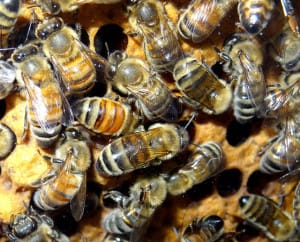The Globe and Mail
by Eric Atkins
 |
The Ontario government has unveiled North America’s first agricultural restrictions on a widely used class of pesticides blamed for the decline in bees and other pollinators.
The controversial regulations aimed at reducing the use of neonicotinoid insecticides made by Bayer AG and Syngenta AG by 80 per cent within two years goes into effect on July 1.
The rules, which are intended to improve the health of insects responsible for pollinating about $900-million worth of crops, require that farmers who use neonic-treated seeds to grow corn and soybeans show they have insect problems, and that seed vendors be licensed.
The province said on Tuesday it wants to reduce the overwintering death rate of honey bees to 15 per cent from an average of 34 per cent by controlling the planting of seeds treated with the three most commonly used neonicotinoids.
Glen Murray, Ontario’s Minister of the Environment, said the rules are “highly workable” and address farmers’ concerns while reducing damage from neurotoxic pesticides that are persisting in streams and soil and affecting everything from birds and bees to butterflies and aquatic life.
Vendors of other pesticides require licences, and the new Ontario rules simply add neonics to that regime, he noted.
Establishing, administering and enforcing the licensing and planting system will cost $3-million to $4-million a year, said Mr. Murray, conceding there is little to prevent anyone from purchasing the treated seeds in the United States.
“We know [farmers] to be honest people,” he said in an interview. “A certain amount of this works on a trust system, frankly.”
Neonics, as they are called, are used by Ontario farmers on almost all corn for grain and about 60 per cent of soybeans. They are applied to the seeds before planting and are designed to protect the crop as it grows from a range of insects and worms.
Growers and the chemical companies that sell the seeds say they are safe if used properly, and are less harmful to people than the types of pesticides neonics have replaced over the past decade.
Pierre Petelle, a spokesman for CropLife Canada, which speaks for the pesticide makers, said the restrictions “lack scientific foundation” and will spur the companies to invest in countries that have been more willing to listen and collaborate.
“The uncertainty created here will certainly have an impact on new technologies being brought to Canada,” Mr. Petelle said in an interview. “We fully expect that innovation pipeline is going to be affected.”
Mr. Petelle did not have neonic-treated seeds sales figures for Ontario, which grows most of Canada’s corn, but said the Canadian market is about 2 per cent of North America’s.
The Grain Farmers of Ontario did not respond to an interview request.
The most popular varieties of neonics are nearing the end of a two-year ban in Europe and are being reviewed by Health Canada. The U.S. government has halted approval of new uses for neonics, and recently released a report showing the pesticide offered no improvement in crop size for soybean growers.
There is a long list of studies linking neonics to honey bee deaths. Chronic exposure through pollen and water has also been shown to limit bees’ abilities to forage and navigate, and makes them less able to withstand virus-bearing mites, long winters and habitat loss.
“To have a significant impact on improving pollinator health, over the coming months, we collectively need to focus on three additional contributors: habitat and nutrition, disease and pests as well as weather and climate change,” said Jeff Leal, Ontario’s Minister of Agriculture, Food and Rural Affairs.
The regulations, first reported by The Globe and Mail last summer, are opposed by the large seed sellers and some farm organizations.
In the battle for public opinion, they have bought ads in newspapers and launched a campaign called Bees Matter that describes the life of a honey bee and the many factors that affect its health.
Greg Sekulic, a spokesman for Bees Matter and an agronomist with the Canola Council of Canada, said in a recent interview honey bees are thriving, pointing to the rising number of managed hives. “We’ve got a very very mutually beneficial relationship with bees and beekeepers and we want to make sure that continues,” Mr. Sekulic said.
According to Statistics Canada, the number of honey bee hives rose by 38 per cent between 1994 and 2014. During the same period, honey production rose by 8 per cent, a gap beekeepers and a scientist at University of Guelph say is due to the methods used to combat the ill effects of pesticides and viruses – splitting sick hives.
According to the rules released on Tuesday:
- For the 2016 growing season, farmers can use neonic-treated seeds to grow 50 per cent of their corn and soybeans.
- To exceed the 50 per cent, they must submit a pest assessment to their seed seller.
- For the 2017 season, farmers cannot use any neonics unless they show they have an insect problem, sign a declaration and take a pest management course.
- Neonic-treated seed sellers must obtain a licence beginning August, 2015, submit annual sales reports to the province and ensure farmers meet the requirements to use treated seeds.
“Assuming Ontario hits its target of an 80-per-cent reduction by 2017, this will be the most important pollinator-protection policy on the continent – and a major contributor to food security,” said Gideon Forman of the Canadian Association of Physicians for the Environment, a group that has campaigned against the blanket use of neonics.

